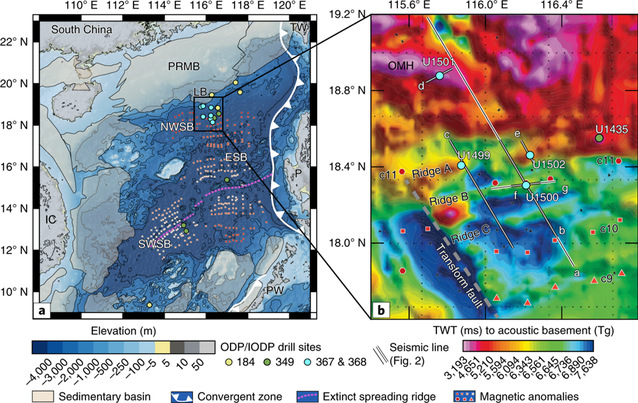H. C. Larsen1,2*, G. Mohn3*, M. Nirrengarten3, Z. Sun4, J. Stock5 , Z. Jian1 , A. Klaus6, C. A. Alvarez-Zarikian 6, J. Boaga 7, S. A. Bowden8, A. Briais 9, Y. Chen10, D. Cukur11, K. Dadd 12, W. Ding13, M. Dorais 14, E. C. Ferré15, F. Ferreira 16, A. Furusawa17, A. Gewecke18, J. Hinojosa5, T. W. Höfig 6, K. H. Hsiung19, B. Huang20, E. Huang1 , X. L. Huang21, S. Jiang22, H. Jin1, B. G. Johnson 23, R. M. Kurzawski 24,25, C. Lei26, B. Li27, L. Li1 , Y. Li28, J. Lin4,29, C. Liu30, C. Liu1, Z. Liu1, A. J. Luna 31, C. Lupi32, A. McCarthy33,50, L. Ningthoujam 34, N. Osono35, D. W. Peate36, P. Persaud 30, N. Qiu4, C. Robinson37, S. Satolli 38, I. Sauermilch39, J. C. Schindlbeck 40, S. Skinner 41, S. Straub42, X. Su4, C. Su 43, L. Tian44, F. M. van der Zwan 24,25, S. Wan 45, H. Wu 46, R. Xiang4, R. Yadav34, L. Yi1 , P. S. Yu 47, C. Zhang 4, J. Zhang4, Y. Zhang 48, N. Zhao 29, G. Zhong1 and L. Zhong49
1 State Key Laboratory of Marine Geology, Tongji University, Shanghai, China.
2 Geological Survey of Denmark and Greenland, Copenhagen, Denmark.
3 Université de Cergy-Pontoise, Laboratoire Géosciences et Environnement Cergy (GEC), Neuville-sur-Oise, France.
4 CAS Key Laboratory of Ocean and Marginal Sea Geology, South China Sea Institute of Oceanology, Guangzhou, China.
5 Division of Geological and Planetary Sciences, California Institute of Technology, Pasadena, CA, USA.
6 International Ocean Discovery Program, Texas A&M University, College Station, TX, USA.
7 Dipartimento di Geoscienze, Università degli Studi di Padova, Padova, Italy.
8 School of Geosciences, University of Aberdeen, Aberdeen, UK.
9 GET, Universite de Toulouse, UMR 5563 CNRS, CmNES, IRD, Obs. Midi-Pyrenees, Toulouse, France.
10 Guangzhou Institute of Geochemistry, Chinese Academy of Sciences,Guangzhou, China.
11 Petroleum & Marine Research Division, Korea Institute of Geoscience and Mineral Resources (KIGAM), Daejeon, Republic of Korea.
12 School of Geosciences, University of Sydney, Camperdown, New South Wales, Australia.
13 Key Laboratory of Submarine Geoscience, Second Institute of Oceanography (SIO), State Oceanic Administration (SOA), Hangzhou, China.
14 Department of Geological Sciences, Brigham Young University, Provo,UT, USA.
15 School of Geosciences, University of Louisiana at Lafayette, Lafayette, LA, USA.
16 Programa de Pós-Graduação em Dinâmica dos Oceanose da Terra da Universidade Federal Fluminense (DOT-UFF), Brazil - CAPES Foundation, Ministry of Education of Brazil, Brasilia, Brazil.
17 Department of Geoscience, Shimane University, Matsue City, Shimane, Japan.
18 Earth and Atmospheric Sciences, University of Nebraska–Lincoln, Lincoln, NE, USA.
19 JAMSTEC, Yokohama, Kanagawa, Japan.
20 Department of Geology, Peking University, Beijing, China.
21 State Key Laboratory of Isotope Geochemistry,Guangzhou Institute of Geochemistry, Chinese Academy of Sciences, Guangzhou, China.
22 Institute of Groundwater and Earth Sciences, Jinan University,Guangzhou, China.
23 Department of Geology and Geography, West Virginia University, Morgantown, WV, USA.
24 GEOMAR Helmholtz Center for Ocean Research , Kiel, Germany.
25 Institute of Geosciences, Christian-Albrechts-Universität zu Kiel, Kiel, Germany.
26 Key Laboratory of Tectonics and Petroleum Resources of Ministry of Education, China University of Geosciences, Wuhan, China.
27 Department of Micropalaeontology, Nanjing Institute of Geology and Palaeontology, Nanjing, China.
28 School of Geographical and Oceanographical Sciences, Nanjing University, Nanjing Shi, China.
29 Department of Geology and Geophysics, Woods Hole Oceanographic Institution, Woods Hole, MA, USA.
30 Department of Geology and Geophysics, Louisiana State University, Baton Rouge, LA, USA.
31 Department of Geology, University of South Florida, Tampa, FL, USA.
32 Department of Earth and Environmental Sciences, Università degli studi di Pavia, Pavia, Italy.
33 Institute of Earth Sciences, University of Lausanne, Geopolis, Lausanne, Switzerland.
34 Department of Marine Geophysics, National Centre for Antarctic and Ocean Research (NCAOR), Vasco Da Gama, Goa, India.
35 Faculty of Science, Graduate School of Science and Technology for Innovation, Yamaguchi-shi, Yamaguchi, Japan.
36 Earth & Environmental Sciences, University of Iowa, Iowa City, IA, USA.
37 School of Earth Sciences, Ohio State University, Columbus, OH, USA.
38 Dipartimento di Ingegneria e Geologia, Università degli studi G D’Annunzio Chieti-Pescara, Chieti, Italy. 39 Institute for Marine and Antarctic Studies (IMAS), University of Tasmania, Hobart, Tasmania, Australia.
40 Institute of Earth Sciences, Heidelberg University, Heidelberg, Germany.
41 Department of Geology, California State University, Sacramento, CA, USA.
42 Lamont Doherty Earth Observatory of Columbia University, Palisades, NY, USA.
43 Institute of Oceanography, National Taiwan University, Tapei, Taiwan.
44 Institute of Deep-sea Science and Engineering, Chinese Academy of Sciences, Sanya City, Hanai Province, China.
45 Institute of Oceanology, Chinese Academy of Sciences, Qingdao, Shandong Province, China.
46 School of Ocean Sciences, China University of Geosciences, Haidian District, Beijing, China.
47 Taiwan Ocean Research Institute, NARLabs, Kaohsiung, Taiwan.
48 Department of Earth, Atmospheric and Planetary Sciences, Purdue University, West Lafayette,IN, USA.
49 School of Marine Sciences, Sun Yat-Sen University, Zhuhai, China.
50 Present address: School of Earth Sciences, University of Bristol , Clifton, UK.
*e-mail: hclarseniodp@gmail.com; geoffroy.mohn@u-cergy.fr
Abstract:
Continental breakup represents the successful process of rifting and thinning of the continental lithosphere, leading to plate rupture and initiation of oceanic crust formation. Magmatism during breakup seems to follow a path of either excessive, transient magmatism (magma-rich margins) or of igneous starvation (magma-poor margins). The latter type is characterized by extreme continental lithospheric extension and mantle exhumation prior to igneous oceanic crust formation. Discovery of magma-poor margins has raised fundamental questions about the onset of ocean-floor type magmatism, and has guided interpretation of seismic data across many rifted margins, including the highly extended northern South China Sea margin. Here we report International Ocean Discovery Program drilling data from the northern South China Sea margin, testing the magma-poor margin model outside the North Atlantic. Contrary to expectations, results show initiation of Mid-Ocean Ridge basalt type magmatism during breakup, with a narrow and rapid transition into igneous oceanic crust. Coring and seismic data suggest that fast lithospheric extension without mantle exhumation generated a margin structure between the two endmembers. Asthenospheric upwelling yielding Mid-Ocean Ridge basalt-type magmatism from normal-temperature mantle during final breakup is interpreted to reflect rapid rifting within thin pre-rift lithosphere.

Full Article::https://www.nature.com/articles/s41561-018-0198-1


